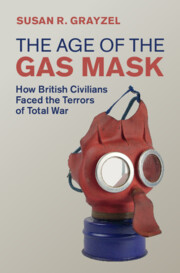Book contents
- The Age of the Gas Mask
- Studies in the Social and Cultural History of Modern Warfare
- The Age of the Gas Mask
- Copyright page
- Dedication
- Contents
- Figures
- Acknowledgments
- Abbreviations
- 1 Introduction
- 2 Inventing an Object for Modern Conflict
- 3 Defending Civilians
- 4 Unveiling the Gas Mask
- 5 Curating the Good Citizen
- 6 Facing Wartime
- 7 Conclusion
- Epilogue
- Notes
- Bibliography
- Index
6 - Facing Wartime
The Civilian Gas Mask’s Rise and Fall, 1941–1945
Published online by Cambridge University Press: 21 July 2022
- The Age of the Gas Mask
- Studies in the Social and Cultural History of Modern Warfare
- The Age of the Gas Mask
- Copyright page
- Dedication
- Contents
- Figures
- Acknowledgments
- Abbreviations
- 1 Introduction
- 2 Inventing an Object for Modern Conflict
- 3 Defending Civilians
- 4 Unveiling the Gas Mask
- 5 Curating the Good Citizen
- 6 Facing Wartime
- 7 Conclusion
- Epilogue
- Notes
- Bibliography
- Index
Summary
While civilians in the metropole had mixed responses to concerted efforts to urge them to carry their gas masks, popular culture continued to make the gas mask an object of humor as well as something to manage panic or fear. As the war continued, new questions emerged that showed the limits of the gas mask’s reach, notably who was responsible for providing gas masks for internees in camps on the Isle of Man or for colonial subjects in places ranging from Aden to India to Singapore to the West Indies. Those planning for civil defense had not considered provisions for those in Britain’s extensive empire, and those in the colonies came to treat imperial civil defense with ambivalence. As Britain’s access to its overseas empire – and most importantly its source of rubber – shifted by the middle of 1942, so too did its instructions about gas masks. It now no longer asked its inhabitants to carry their gas masks everywhere but instead to ensure that they knew where they were and would keep them in good order. Despite poison gas not being deployed in massive attacks on civilians, as feared in the planning stages, the government continued to provide babies’ anti-gas protective helmets to all infants, and to inspect and repair gas masks for other ages throughout the war. At the war’s end, however, it decided not to collect these devices, just in case they could be of use in a future war.
Keywords
- Type
- Chapter
- Information
- The Age of the Gas MaskHow British Civilians Faced the Terrors of Total War, pp. 174 - 193Publisher: Cambridge University PressPrint publication year: 2022

